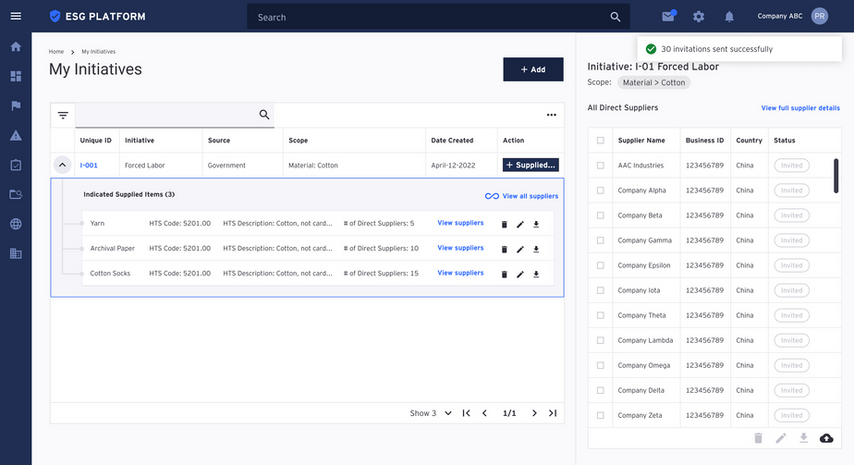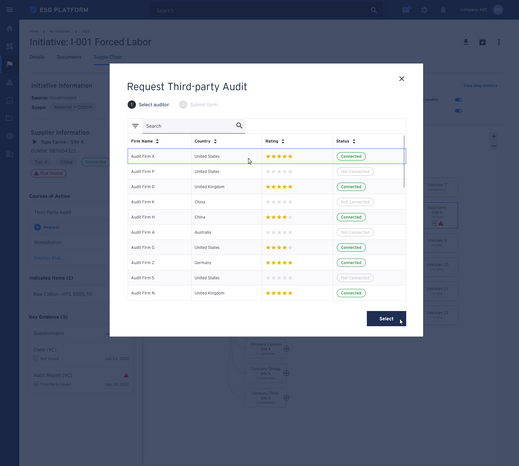SENIOR UX DESIGNER @ EY
Innovating responsible supply-chain MIS for pitch
WIREFRAMES
COMPLEX SYSTEM
BLOCKCHAIN
PROBLEM
How might we cultivate transparent and ethical supply chains while preserving data privacy and confidentiality via blockchain?
-
Forced labor remains a hidden but pervasive issue within global supply chains, perpetuated by complex, opaque networks and inadequate oversight. Economic pressures, weak enforcement of labor laws, and insufficient corporate transparency contribute to the exploitation, posing legal, reputational, and operational risks to businesses.
-
Effective mitigation demands robust regulatory frameworks, corporate accountability, and collaborative efforts across governments, companies, and civil society.
WORK CONTEXT
Only UX designer on team of blockchain developers
-
Team: 1 designer (me), 1 product manager, 1 associate director of blockchain, 5 developers
-
What I Did: Co-led business logic and concept development; Conducted research; Owned visualization through rapid prototyping, information architecture, and design system development; Significant contribution to schema design of verification certificates (VC); Produced design deliverables for storytelling pitches and prototype development
-
Skills: Competitive research, domain research, information architecture, schema design, classification structures, usability design, user flow diagramming, UI design, rapid prototyping
-
Timeline: Oct 2021 - June 2022 (8 months)
-
Tools: Figma, Mural, EY Motif DS, Material DS, Powerpoint, MS Excel

SOLUTION
Collaborative, networked risk management system for supply-chain ecosystem
I co-conceptualized and prototyped a muti-party stakeholder risk management platform, leveraging proprietary ZKP technology.
-
Initiative-driven scoping and tracking of ethical supply-chain initiatives
-
Global directory of registered organizations and supply-chain mapping
-
Verifiable assertions and supported by private and immutable blockchain records
-
Risk-focused task management
-
Transparency in external audits




INSIGHTS
To bridge transparency and trust between stakeholders, a risk management system for ethical supply chain accountability needs flexibility.
1. Problem identification
-
Risk Management Needs: The principal organization needs to initiate risk management in response to internal, external, or government initiatives.
-
Limited Supply Chain Visibility: Companies can only see one tier down in their supply chain due to confidentiality agreements with sub-suppliers, preventing full transparency.
-
Conflicting Stakeholder Needs:
-
Government customs agencies want transparency when inspecting imports.
-
Companies want to know about risks but avoid third-party visibility that might hinder their business.
-
Human rights NGOs want to report on suspected forced labor.
-
-
Guilty Parties: Those responsible for forced labor are unlikely to volunteer their involvement, making detection difficult.
2. Stakeholder Research & Insights
-
Stakeholder Perspectives: Conflicting needs between different groups such as government, industry, auditing, and NGOs.
-
Supply Chain Transparency: Companies need a system to help identify risks and take action without exposing risks to third parties and interrupting their business.
3. Ethical Considerations
-
Ethical Compliance Options: Different interpretations of what ethical supply chain compliance could mean, with an analysis of the challenges and best paths forward.
4. Solution Design
-
Proposed Flexible Architecture: A system that supports flexible, comprehensive risk management based on initiatives and varying stakeholder needs (government, industry, NGOs).
-
Visual Supply Chain Mapping: A tool to help companies identify risk sources and impacted suppliers more easily.
-
Blockchain-Based Verification Certificates: Schema design for verification certificates using blockchain, integrated into the system’s information architecture to verify compliance.
-
Information Models: Produced presentations addressing information models, process mechanics, and classification structures.
-
Schemas and Controlled Vocabulary: Lead discussions on schemas, semantic meaning, and controlled vocabulary to standardize and manage supply chain data for risk management.
"Produced presentations addressing information models, process mechanics, and classification structures"
5. System Features
-
Risk Management Actions: A system designed based on SME feedback that offers comprehensive status tracking and documentation management for risk management.
-
Blockchain Integration: Diagramming how blockchain records could be verified and integrated for supply chain compliance and ethical practices.
OUTCOME
Won executive buy-in for continued exploration and funding
I produced 54 hi-fidelity screens in 3 days followed by more complete interactive prototypes, enabling a functional proof of concept for the development team to successfully demo to stakeholders. Design screens were also used for storytelling pitches.
WHAT I'D DO DIFFERENTLY
Advocate for months of deep research before prototyping
-
By reserving a dedicated meeting time for project kickoff with key stakeholders, I could have advocated for the value of research and propose the design of a research plan.
-
By designing a series of studies, I could have collected pertinent information from available stakeholders to learn more about their experiences, goals, risks, challenges, open questions, and who other stakeholders may be.
-
By identifying all stakeholders upfront, I could have worked with leadership to uncover conflicting interests earlier, better informing the strategy and scope.
-
By maintaining a shared project management space for research and strategy, the team could enhance collaborative efforts and maintain greater transparency.
-
By proving the value of a research-first approach that worked around our research limitations, I may have gained support for my internal "UX agency" proposal.
-
My open questions: Where is the line between government oversight and free markets? What ISO standards would be needed to make a system like this work on a global scale?






















